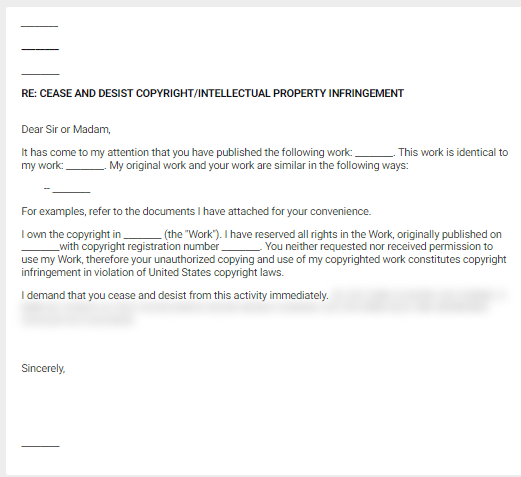Have you ever found yourself in a situation where someone was using your work or property without your permission? Maybe it’s a company using your trademark or a neighbor who keeps trespassing on your property. In these cases, it can be frustrating and stressful to figure out how to stop the offending party.
This is where a cease and desist letter can be a powerful tool. A cease and desist letter is a legal document that demands the recipient to immediately stop certain activities that are infringing upon your rights. It is a formal way of telling someone that they are breaking the law and that they need to stop.
Sending a cease and desist letter can be an effective first step in protecting your rights and preventing further harm. It’s a way to assert your position without resorting to costly and time-consuming legal action.
But how do you write a cease and desist letter that is both effective and legally sound? That’s where this guide comes in. We’ll walk you through the legal considerations, the key elements of a cease and desist letter, and provide you with templates that you can use as a starting point. By the end of this guide, you’ll have the knowledge and tools you need to draft a strong and effective cease and desist letter in Australia.
Table Of Content
- Legal Considerations
- Discussion of relevant Australian laws and regulations
- Explanation of the legal grounds for sending a cease and desist letter
- Elements of a Cease and Desist Letter
- How to Draft a Cease and Desist Letter
- Cease and Desist Letter Templates
- Conclusion
- FAQs
Legal Considerations

Before you send a cease and desist letter, it’s important to understand the legal considerations involved. In Australia, there are several laws and regulations that govern the use of cease and desist letters.
One key consideration is the legal grounds for sending a cease and desist letter. In general, a cease and desist letter can be sent when someone is infringing upon your legal rights, such as your intellectual property or your right to privacy. For example, you may send a cease and desist letter to a company that is using your trademark without permission, or to a neighbor who is repeatedly trespassing on your property.
However, it’s important to ensure that your claims are legally valid before sending a cease and desist letter. Making false or unfounded claims can lead to legal trouble and damage to your reputation. It’s a good idea to consult with a legal professional before sending a cease and desist letter to ensure that your claims are legally sound.
Another consideration is the language and tone used in the cease and desist letter. While it’s important to assert your position, it’s equally important to avoid making threats or engaging in aggressive behavior. A well-crafted cease and desist letter should be firm, but also professional and respectful.
By understanding the legal considerations involved in sending a cease and desist letter, you can ensure that your letter is effective and legally sound. In the next section, we’ll discuss the key elements of a cease and desist letter so that you can start drafting your own.
Discussion of relevant Australian laws and regulations
When it comes to sending a cease and desist letter in Australia, there are several laws and regulations that you should be aware of. These laws and regulations can vary depending on the specific situation and circumstances involved, but here are a few key legal considerations to keep in mind:
- Australian Consumer Law (ACL) The Australian Consumer Law (ACL) is a national law that sets out consumer rights and protections. Under the ACL, it is illegal for a business to engage in misleading or deceptive conduct, including making false or misleading claims about their products or services. If someone is infringing upon your consumer rights, you may be able to send a cease and desist letter to demand that they stop.
- Copyright Law Copyright law in Australia protects original works of authorship, such as music, art, literature, and software. If someone is using your copyrighted work without your permission, you may be able to send a cease and desist letter to demand that they stop. However, it’s important to note that there are some exceptions to copyright law, such as fair use or fair dealing, which allow for limited use of copyrighted material in certain circumstances.
- Trademark Law Trademark law in Australia protects registered trademarks, which are unique symbols, names, logos, or phrases used to identify a business or product. If someone is using your registered trademark without your permission, you may be able to send a cease and desist letter to demand that they stop.
- Defamation Law Defamation law in Australia protects individuals and businesses from false statements that could harm their reputation. If someone is making false and harmful statements about you or your business, you may be able to send a cease and desist letter to demand that they stop.
It’s important to note that these are just a few examples of the legal considerations involved in sending a cease and desist letter in Australia. Depending on your specific situation, there may be additional laws or regulations that you need to consider. It’s always a good idea to consult with a legal professional to ensure that your claims are legally valid and that your letter is effective and legally sound.
Explanation of the legal grounds for sending a cease and desist letter
Sending a cease and desist letter is a legal tool that can be used to demand that someone stop engaging in certain activities that are infringing upon your legal rights. In Australia, there are several legal grounds for sending a cease and desist letter, including:
- Infringement of Intellectual Property Rights If someone is using your copyrighted work, trademark, or other intellectual property without your permission, you may be able to send a cease and desist letter to demand that they stop. This can include cases where someone is using your intellectual property without attribution, or cases where someone is using your intellectual property in a way that is not authorized by law.
- Breach of Contract If you have a contractual agreement with someone and they have breached the terms of that agreement, you may be able to send a cease and desist letter to demand that they stop. This can include cases where someone is not fulfilling their obligations under the contract or cases where someone is using your property in a way that is not authorized by the contract.
- Trespass or Nuisance If someone is repeatedly trespassing on your property or causing a nuisance that is interfering with your ability to enjoy your property, you may be able to send a cease and desist letter to demand that they stop. This can include cases where someone is playing loud music late at night, blocking your driveway, or otherwise interfering with your property rights.
- Defamation If someone is making false and harmful statements about you or your business, you may be able to send a cease and desist letter to demand that they stop. This can include cases where someone is making defamatory statements about you online or in print.
It’s important to note that these are just a few examples of the legal grounds for sending a cease and desist letter in Australia. Depending on your specific situation, there may be additional legal grounds that you need to consider. It’s always a good idea to consult with a legal professional to ensure that your claims are legally valid and that your letter is effective and legally sound.
Elements of a Cease and Desist Letter
When drafting a cease and desist letter in Australia, there are certain elements that should be included to ensure that the letter is effective and legally sound. These elements include:

- Identification of the Sender The letter should clearly identify who is sending the letter, including their full name and contact information. This will help to establish the sender’s authority to make the demands outlined in the letter.
- Identification of the Recipient The letter should clearly identify who the letter is being sent to, including their full name and contact information. This will help to ensure that the letter is delivered to the correct person or organization.
- Description of the Infringing Activity The letter should clearly describe the infringing activity that is the subject of the letter. This may include specific examples of the activity, as well as any evidence that supports the sender’s claims.
- Demand to Cease and Desist The letter should clearly demand that the recipient immediately cease and desist from the infringing activity. This demand should be specific and include details about what the recipient must do to comply with the demand.
- Threat of Legal Action The letter may include a threat of legal action if the recipient does not comply with the demand to cease and desist. This can include a warning that the sender will pursue legal action to enforce their rights if necessary.
- Timeframe for Compliance The letter should specify a timeframe within which the recipient must comply with the demand to cease and desist. This timeframe should be reasonable and give the recipient enough time to take action to comply with the demand.
- Acknowledgment of Receipt The letter should include a request for the recipient to acknowledge receipt of the letter, either by signing and returning a copy of the letter or by contacting the sender in writing to confirm receipt.
It’s important to note that these are just some of the elements that should be included in a cease and desist letter in Australia. Depending on your specific situation, there may be additional elements that you need to include to ensure that your letter is effective and legally sound. It’s always a good idea to consult with a legal professional to ensure that your letter is drafted correctly and includes all necessary elements.
How to Draft a Cease and Desist Letter
Drafting a cease and desist letter can be a complex and sensitive process. To ensure that your letter is effective and legally sound, there are certain steps that you should follow:
- Identify the Infringing Activity The first step in drafting a cease and desist letter is to identify the infringing activity that you want to stop. This may involve conducting research and gathering evidence to support your claims.
- Determine the Legal Grounds Next, you should determine the legal grounds for your demand to cease and desist. This will help you to frame your demands in a way that is legally valid and enforceable.
- Consult with a Legal Professional It’s always a good idea to consult with a legal professional before drafting a cease and desist letter. A legal professional can help you to understand your legal rights and obligations, as well as provide guidance on how to draft an effective and legally sound letter.
- Draft the Letter Once you have gathered the necessary information and consulted with a legal professional, you can begin drafting your cease and desist letter. Be sure to include all necessary elements, such as identifying information for both the sender and recipient, a clear description of the infringing activity, and a specific demand to cease and desist.
- Review and Revise the Letter After drafting the letter, it’s important to review and revise it carefully. Check for any errors or omissions, and ensure that the language used is clear and concise.
- Send the Letter Finally, you should send the letter to the recipient using a delivery method that provides proof of delivery. This may include registered post or email with a read receipt.
In summary, drafting a cease and desist letter in Australia requires careful consideration of the legal grounds for your demand, consultation with a legal professional, and attention to detail when drafting and sending the letter. By following these steps, you can increase the likelihood that your letter will be effective in stopping the infringing activity and protecting your legal rights.
Cease and Desist Letter Templates
When it comes to drafting a cease and desist letter, there are several templates available that can be used as a starting point. However, not all templates are created equal, and some may be more suitable for certain situations than others.
Here’s a comparison of different templates and their suitability for different situations:
- LegalVision Cease and Desist Letter Template: The LegalVision template is a comprehensive and well-organized template that includes all necessary elements for a cease and desist letter. It’s suitable for a wide range of situations, including those related to copyright, trademark, and general breach of contract.
- Lawpath Cease and Desist Letter Template: The Lawpath template is also comprehensive and includes all necessary elements, as well as customizable sections for specific details related to your situation. It’s suitable for a wide range of situations, including those related to breach of contract, copyright, and trademark.
- IP Australia Cease and Desist Letter Template: The IP Australia template is specifically related to trademark infringement and may not be suitable for other types of situations. However, it includes all necessary elements and is customizable to your specific situation.
- DIY Templates: There are also a number of DIY templates available online that can be used as a starting point for drafting a cease and desist letter. However, these templates may not be as comprehensive or legally sound as templates provided by legal professionals.
LegalVision Cease and Desist Letter Template
Lawpath Cease and Desist Letter Template
IP Australia Cease and Desist Letter Template
Cease and Desist Letter Australia Example
[Date][Name of person you are sending the letter to][Address of person you are sending this letter to]Dear [Name of person]:
I am writing to inform you that I have been using the trademark “[name of trademark]” since [date], and I believe that you have recently registered this trademark. However, I believe that you do not have any rights over my trademark, because I have been using it for more than three years before your registration date. Therefore, please immediately stop using my trademark and remove it from all your materials. If there has been any confusion regarding our trademarks or if you would like to discuss this matter further, please contact me at [phone number].
Cease and Desist letter nsw template
Dear [recipient’s name]:
We are writing to demand that you immediately stop engaging in the unauthorized practice of law. We have been informed that you have violated your ethical obligations as an attorney by providing legal advice or services to others without the supervision of a licensed attorney. Your conduct is a violation of Rule 7.1(a) of the Rules Regulating The Florida Bar (“Rules”).’ The record further shows that you have engaged in similar conduct throughout your entire career as an attorney and continue to do so despite multiple warnings from this office. You are hereby notified that should you continue engaging in the unauthorized practice of law, we will file formal charges against you before The Florida Bar.’
Cease and Desist letter qld template
Dear [name],
This is a Cease and Desist letter. This letter is to inform you that your actions in the past few weeks have been unacceptable. We are hoping that this letter will be enough to bring this situation to an end.
If you do not comply with this letter by [date], we will be forced to take legal action against you and your company. This will include a lawsuit against both yourself and your business, as well as any other appropriate legal actions we may take.
Cease and Desist Letter Defamation Australia Template
To:
[Insert Name][Insert Address]Dear [insert name],
I am writing to you as the lawyer for [name of client]. It has come to my attention that you have been making false statements about [client] on social media and in other forums. These statements are defamatory in nature and have caused substantial harm to my client’s reputation. You are hereby directed to cease and desist any further publication of these false statements immediately. If you fail to do so, I will take legal action against you. Please contact me at your earliest convenience so that we can discuss this matter further. Thank you for your prompt attention to this matter.
Sample Cease and Desist Letter Australia
Dear Sir or Madam,
This letter is a formal notice of copyright infringement. I have good faith belief that the use of the material in the manner complained of is not authorized by the copyright owner, its agent, or the law. The information in this notice is accurate, and I am authorized to act on behalf of the owner of an exclusive right that is infringed.
I consider that the use of [describe what you object to] by you without my permission infringes my exclusive rights under [insert relevant provision(s) of the Copyright Act] and I request that you immediately do not engage in such acts or any other acts that infringe my rights again.
If you do not comply with this request, I shall seek remedial action against you without further notice to yourself
In summary, when choosing a template for a cease and desist letter, it’s important to consider the specific situation you’re dealing with and choose a template that includes all necessary elements and is legally sound. Templates provided by legal professionals, such as the LegalVision and Lawpath templates, are generally more comprehensive and suitable for a wide range of situations. However, it’s always a good idea to consult with a legal professional before sending a cease and desist letter to ensure that your rights are fully protected.
Conclusion
In conclusion, a cease and desist letter is a useful legal tool that can be used to stop infringing activity and protect your legal rights. However, it’s important to understand the legal considerations and elements of a cease and desist letter before sending one.
Using a template can be a helpful starting point for drafting a cease and desist letter, but it’s important to customize the letter to your specific situation and ensure that it includes all necessary elements. It’s also important to choose a template that is suitable for your situation and consider consulting with a legal professional before sending the letter.
By following these guidelines and taking the necessary steps to ensure that your cease and desist letter is legally sound and effective, you can increase the likelihood that the infringing activity will be stopped and your legal rights will be protected.
Remember, sending a cease and desist letter should always be approached with caution and care, as it can sometimes escalate a situation. If you’re unsure about whether to send a cease and desist letter or how to go about it, it’s always a good idea to consult with a legal professional who can provide guidance and advice.
FAQs
1. Is a cease and desist letter enforceable
In Australia, a cease and desist letter is not a legally binding document, but it can be used as evidence in court proceedings. The letter can serve as a warning to the recipient that their behavior is infringing on your legal rights and that you intend to take legal action if the behavior continues.
If the recipient continues to engage in the infringing activity after receiving the cease and desist letter, legal action may be necessary to enforce your rights. This may involve filing a complaint with the appropriate regulatory agency or initiating legal proceedings in court.
It’s important to note that sending a cease and desist letter does not guarantee that the infringing activity will stop, and it can sometimes escalate the situation. Before sending a cease and desist letter, it’s always a good idea to consult with a legal professional who can advise you on the best course of action based on your specific situation.
2.Can I file a cease and desist letter
A cease and desist letter is not a legal filing or formal complaint that can be lodged with a court or regulatory agency in Australia. Rather, it is a letter sent by an individual or their legal representative to inform another party that they believe their rights are being infringed upon and to demand that the infringing behavior cease.
While a cease and desist letter is not a formal legal filing, it can serve as a warning to the recipient that legal action may be taken if the infringing behavior does not cease. If the recipient continues the behavior, legal action may be necessary to enforce your rights, and this may involve filing a complaint with the appropriate regulatory agency or initiating legal proceedings in court.
It’s important to note that before sending a cease and desist letter, it’s recommended to consult with a legal professional who can advise you on the best course of action based on your specific situation. They can also assist with drafting the letter to ensure that it is legally sound and effective in achieving your desired outcome.
3.Do i need a lawyer to write a cease and desist letter
While it is not a requirement to have a lawyer draft a cease and desist letter in Australia, it is highly recommended. Cease and desist letters involve complex legal issues, and a lawyer can ensure that the letter is drafted in accordance with Australian laws and regulations, and that the legal basis for the demand is clearly stated.
A lawyer can also provide valuable guidance on the best approach for your specific situation and advise you on the potential risks and benefits of sending a cease and desist letter. They can also assist in negotiating a resolution with the other party, potentially avoiding the need for further legal action.
Additionally, a lawyer can help ensure that the letter is effective in achieving its desired outcome, such as stopping the infringing behavior or obtaining compensation for damages. If the recipient does not comply with the demands in the letter, the lawyer can also advise you on the appropriate next steps, such as filing a complaint with the appropriate regulatory agency or initiating legal proceedings in court.
Overall, while it is possible to draft a cease and desist letter without a lawyer, it is highly recommended to seek legal advice to ensure that the letter is effective and legally sound.
4. Who writes a cease and desist letter
A cease and desist letter can be written by anyone who has legal standing to demand that the recipient stop engaging in certain behavior that is infringing on their rights. This may include individuals, businesses, or organizations.
While a lawyer is not required to write a cease and desist letter in Australia, it is highly recommended to seek legal advice and assistance in drafting the letter. A lawyer can ensure that the letter is legally sound, that the legal basis for the demand is clearly stated, and that the language is professional and appropriate.
However, individuals or businesses can also draft their own cease and desist letter if they have a good understanding of the relevant laws and regulations, and are confident in their ability to effectively communicate their demand. It’s important to keep in mind that a poorly drafted letter can actually harm your case or escalate the situation, so it’s recommended to seek legal advice if you have any doubts or questions about how to proceed.
5. How to send a cease and desist letter
- Choose a delivery method: You can send the cease and desist letter via mail or email, or hand-deliver it if possible. It’s important to choose a method that allows you to confirm that the letter was received by the intended recipient.
- Address the letter to the recipient: Address the letter to the person or entity that is engaging in the infringing behavior. Make sure to spell their name correctly and use their correct contact information.
- Keep a copy for yourself: Make sure to keep a copy of the letter and any supporting documentation for your records.
- Follow up if necessary: If you don’t receive a response or if the infringing behavior continues after the specified deadline, you may need to take further legal action. Consult with a legal professional to determine your options and next steps.
It’s important to note that the specific requirements for sending a cease and desist letter may vary depending on the circumstances of the situation. It’s recommended to consult with a legal professional to ensure that you are following the appropriate procedures and that your letter is legally sound and effective in achieving your desired outcome.
6. Does a cease and desist letter have to be notarized
A cease and desist letter does not need to be notarized in Australia. Notarization is a process of having a notary public authenticate a legal document by verifying the identity of the person signing it and witnessing their signature. While notarization may be required for certain legal documents, it is not typically required for a cease and desist letter.
However, it’s important to keep in mind that the legal requirements for a cease and desist letter in Australia may vary depending on the circumstances of the situation. It’s recommended to consult with a legal professional to ensure that you are following the appropriate procedures and that your letter is legally sound and effective in achieving your desired outcome.
7. Can you send a cease and desist letter without a lawyer
Yes, it is possible to send a cease and desist letter without a lawyer in Australia. However, it’s important to keep in mind that a cease and desist letter is a legal document and should be written in a professional and legally sound manner to be effective. If you decide to write the letter yourself, it’s recommended that you have a good understanding of the relevant laws and regulations, and that you follow the appropriate legal procedures.
It’s also important to note that a poorly drafted cease and desist letter can actually harm your case or escalate the situation, so it’s recommended to seek legal advice if you have any doubts or questions about how to proceed. A lawyer can ensure that the letter is legally sound, that the legal basis for the demand is clearly stated, and that the language is appropriate and professional.
If you decide to send a cease and desist letter without a lawyer, make sure to keep a copy of the letter and any supporting documentation for your records, and follow up if necessary to ensure that the infringing behavior has stopped.
8. Cease and desist letter cost Australia
The cost of sending a cease and desist letter in Australia can vary depending on several factors, such as the complexity of the case, the type of infringement involved, and whether or not you decide to hire a lawyer to draft the letter.
If you choose to hire a lawyer to draft the letter, the cost can range from a few hundred dollars to several thousand dollars, depending on the complexity of the case and the amount of time involved. Some lawyers may charge an hourly rate, while others may charge a flat fee.
If you decide to write the letter yourself, the main costs involved would be the cost of postage or courier to send the letter to the recipient. The cost of postage within Australia varies depending on the weight of the letter and the destination, but typically ranges from around $1 to $5 AUD.
It’s important to keep in mind that the cost of a cease and desist letter may be only the beginning of the costs involved in enforcing your legal rights. If the recipient does not comply with the letter and you need to take legal action, further costs such as court fees and legal fees may be involved.
Overall, the cost of a cease and desist letter in Australia can vary greatly depending on the specific circumstances of the case, and it’s recommended to seek legal advice to get a better understanding of the costs involved.







